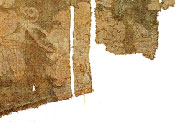 |
 |
||||||||||||||||
 |
|||||||||||||||||
 |
|||||||||||||||||
| Classified Glossary | |||||||||||||||||
 |
|||||||||||||||||
 |
|||||||||||||||||
| 12. 1Twill Indicated by a/b, with a referring to the number of warp threads above the weft threads, b referring to the number of weft threads under the warp threads in one weave unit. Twill direction (xiexiang) is indicated by S or Z indicating the diagonal direction of the twill. The variations are composite twill (fuhexiewen), broken twill (poxiewen), chevron twill (shanxingxiewen), zigzag twill (juchixingxiewen), and lozenge or diamond twill (lingxingxiewen). All of them except broken twill are found in the Shang dynasty. 13. 1Satin Indicated by a/b(i), a referring to the number of warp threads above weft threads and b referring to the number of warp threads under the weft threads in one weave unit, either a or b have to be 1. The interruption used in the Western system has a similar meaning as feishu in Chinese but with a little difference (feishu = interruption + 1). In regular satin (guizeduanwen), the interruption is constant, while the irregular satin (buguizeduanwen) varies. Satin systems appeared in the late Tang dynasty, earlier than satin damask which first appeared in the Yuan dynasty. 14. 1Patterning Using different methods to apply decorations on a textile creates a figure, as in woven figure (zhihua), printed figure (yinhua), embroidered figure (xiuhua). For woven figure, the term pattern (tun) is preferred, as in pattern picking (tiaohua) and patterning (tihua) which refers specially to the mechanical patterning with a patterning system in the process of weaving. The term jacquard, which is used often to describe patterned textiles, should only be applied to patterned textiles created on Jacquard looms. |
|||||||||||||||||
| THE BOOK | |||||||||||||||||
| AUTHOR | |||||||||||||||||
| CONTENTS | |||||||||||||||||
| ORDER | |||||||||||||||||
| CONTACT | |||||||||||||||||
| LINKS | |||||||||||||||||